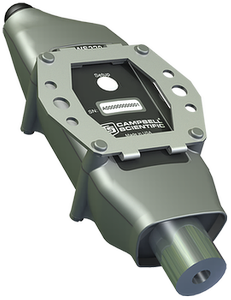This product is not available for new orders.

| Services Available | |
|---|---|
| Repair | No |
| Calibration | No |
| Free Support | No |
Visão Geral
The CWS220A is a wireless version of our SI-111 infrared radiometer. It measures the surface temperature of an object without physical contact. This radiometer has an internal 922 MHz spread-spectrum radio that transmits data to a CWB100A Wireless Base Station or to another wireless sensor. The 922 MHz frequency is used in Australia, Israel, and other countries worldwide.
Leia maisBenefícios e Características
- Provides road surface, plant canopy, soil surface, snow surface, and water surface temperature measurements
- Internal frequency-hopping, spread-spectrum radio provides longer range and less interference
- Battery powered
- A reliable, low-maintenance, low-power method for making measurements in applications where cabled sensors are impractical or otherwise undesirable
- Transmissions can be routed through up to three other wireless sensors
- Measures surface temperature continuously in the field
- Ideal for providing spatial averages
- Compatible with CR800, CR850, CR1000, and CR3000 dataloggers
imagens

Descrição Técnica
The CWS220A includes a thermopile, which measures surface temperature, and a thermistor, which measures sensor body temperature. The two temperature sensors are housed in a rugged body that contains a germanium window. It is battery powered using either alkaline batteries or a rechargeable battery and a solar cell.
The CWS220A can route its transmissions through up to three other wireless sensors. A data logger is connected to the CWB100A base station for processing and storing its data. The CWS220A interfaces with a PC for configuration via the A205 CWS Sensor to PC Interface.
The calibration coefficients used for determining the target temperature by means of the Stefan-Boltzman equation are stored in the CWS220A at the time of calibration.
Why Wireless?
There are situations when it is desirable to make measurements in locations where the use of cabled sensors is problematic. Protecting cables by running them through conduit or burying them in trenches is time consuming, labor intensive, and sometimes not possible. Local fire codes may preclude the use of certain types of sensor cabling inside of buildings. In some applications measurements need to be made at distances where long cables decrease the quality of the measurement or are too expensive. There are also times when it is important to increase the number of measurements being made but the data logger does not have enough available channels left for attaching additional sensor cables.
| Note: The internal radio is not designed to move a lot of data quickly. It takes 15 to 30 seconds per hop when moving data from a sensor, through a sensor used as a repeater, and ending up at the base radio. Going through three repeaters could take a data packet anywhere from 45 to 90 seconds to get to the base radio. |
Compatibilidade
Please note: The following shows notable compatibility information. It is not a comprehensive list of all compatible products.
Data Loggers
| Product | Compatible | Note |
|---|---|---|
| CR1000 (retired) | ||
| CR200X (retired) | ||
| CR206X (retired) | ||
| CR211X (retired) | ||
| CR216X (retired) | ||
| CR295X (retired) | ||
| CR3000 (retired) | ||
| CR5000 (retired) | ||
| CR6 | The CR6 datalogger must have data logger OS version 4.0 or higher. | |
| CR800 (retired) | ||
| CR850 (retired) | ||
| CR9000X (retired) |
Additional Compatibility Information
Mounting
The CWS220A mounts to a mast or pole via the the 26054 bracket. It is mounted at an appropriate distance from the target where it can measure an individual leaf, a canopy, or any surface of interest. Because the CWS220A is wireless, it can be mounted in many locations that would be problematic for a cabled sensor.
Especificações
| Weather Resistance | IP67 rating for sensor and battery pack (Battery pack must be properly installed. Each sensor is leak tested.) |
| Operating Temperature Range | -25° to +50°C |
| Operating Relative Humidity | 0 to 100% |
| Power Source | 2 AA batteries with a battery life of 1 year assuming sensor samples taken every 10 minutes. (Optional solar charging available.) |
| Average Current Drain | 300 μA (with 15-minute polling) |
| Response Time | < 1 s (to changes in target temperature) |
| Target Temperature Output Signal | 60 μV per °C difference from sensor body |
| Body Temperature Output Signal | 0 to 2500 mV |
| Optics | Germanium lens |
| Wavelength Range | 8 to 14 μm (Corresponds to atmospheric window.) |
| Field of View (FOV) | 22° half angle |
| Absolute Accuracy |
|
| Uniformity |
|
| Repeatability |
|
| Dimensions | 15 x 6 x 4.5 cm (5.9 x 2.4 x 1.77 in.) |
| Weight | 270 g (9.6 oz) |
Internal 25 mW FHSS Radio |
|
| Frequency | 920 to 928 MHz |
| Where Used | Australia and New Zealand |
| FHSS Channel | 50 |
| Transmitter Power Output | 25 mW (+14 dBm) |
| Receiver Sensitivity | -110 dBm (0.1% frame error rate) |
| Standby Typical Current Drain | 3 μA |
| Receive Typical Current Drain | 18 mA (full run) |
| Transmit Typical Current Drain | 45 mA |
| Average Operating Current | 15 μA (with 1-second access time) |
| Quality of Service Management | RSSI |
| Additional Features | GFSK modulation, data interleaving, forward error correction, data scrambling, RSSI reporting |
Documentos Relacionados
Downloads
CWS220 Firmware v.5 (442 KB) 30-03-2016
Latest firmware for the CWS220.
Wireless Sensor Planner v.1.7 (30.5 MB) 08-08-2013
The Wireless Sensor Planner is a tool for use with Campbell Scientific wireless sensors. It assists in designing and configuring wireless sensor networks.

